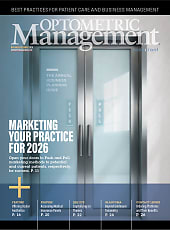PTERYGIA ARE fibrovascular degenerations of the bulbar conjunctiva that extend onto the corneal surface, often resulting in regular and irregular astigmatism (Chu et al, 2020). Ultraviolet light exposure is thought to be a primary environmental risk factor, with the highest prevalence near the equator (He and Wu, 2022; Baheran et al, 2023). Pterygia can be surgically excised with a conjunctival autograft, but recurrence is possible (Chu et al, 2020). This case presents the contact lens management of a patient who has pterygium and seeks visual improvement.
A 68-year-old male presented for contact lens fitting for his left eye. He previously had bilateral photorefractive keratectomy. He had significant nasal pterygia in both eyes and a history of 2 surgical excision procedures on his right eye, with residual scarring. Both eyes had significant regular and irregular astigmatism related to the pterygia.
His uncorrected visual acuity was 20/200 OD and 20/30 OS. Manifest refraction was +2.25 –3.50 x 001 20/30 OD and +0.25 –1.75 x 179 20/25 OS. He had a history of wearing a 16.5 mm scleral lens on his right eye, providing 20/20 acuity. For his left eye, he had intermittently been using a soft daily disposable lens (etafilcon A, 8.6 mm base curve [BC], a 14.5 mm diameter, plano –1.75 x 180 20/25), mostly for golf. The patient was interested in being fit with a lens that provided improved vision like what was achieved with his right scleral lens.
Slit lamp exam was remarkable for mild blepharitis, nasal pterygium, and mild nuclear sclerosis. Corneoscleral topography showed moderate cornea and bulbar conjunctival/scleral irregularity OS.
Contact lens options for correcting both regular and irregular astigmatism included fitting him with a corneal GP, hybrid, or scleral lens. A corneal GP lens was ruled out due to the difficulty of fitting the highly irregular cornea and paralimbal region, in addition to the patient’s high exposure to wind and dust when golfing. A hybrid lens was considered, but ruled out due to a lack of customization options needed to properly fit the nasal asymmetry resulting from the pterygium.
A scleral lens was chosen because it can be completely customized to account for both corneal and scleral irregularity, and the patient already had experience wearing a scleral lens on his right eye. A 16.5 mm free-form scleral lens (hexafocon A) was designed from corneoscleral topography with a BC of 45 D, sagittal depth of 5,162 microns, power –6.43 D, giving him 20/20 acuity (Figure 1). This completely customized scleral lens was able to properly vault over the cornea and the landing zone landed without compression. He was satisfied with both the vision and comfort that his free-form scleral lens provided.

It isn’t uncommon when fitting specialty lenses to have patients wearing a different type of lens on each eye, depending on the circumstances and severity of their condition. Although not necessarily unsuccessful with the previous daily disposable lens for his left eye, this patient eventually recognized the benefit of improved visual acuity that a scleral lens provided for his right eye and wanted that level of performance for the left.
References
1. Chu WK, Choi HL, Bhat AK, Jhanji V. Pterygium: new insights. Eye (Lond). 2020 Jun;34(6):1047-1050. doi: 10.1038/s41433-020-0786-3
2. He S, Wu Z. Biomarkers in the Occurrence and Development of Pterygium. Ophthalmic Res. 2022;65(5):481-492. doi: 10.1159/000523878. Erratum in: Ophthalmic Res. 2022 Nov 3;66(1):319. doi: 10.1159/000527304
3. Baheran SS, Alany RG, Schwikkard S, Muen W, Salman LN, Freestone N, Al-Kinani AA. Pharmacological treatment strategies of pterygium: Drugs, biologics, and novel natural products. Drug Discov Today. 2023 Jan;28(1):103416. doi: 10.1016/j.drudis.2022.103416



